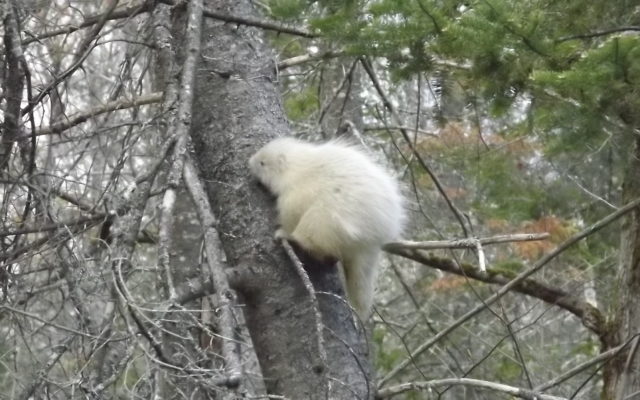
Albino baby porcupine a bright spot in the pandemic gloom
On the list of “least welcome critters,” many Mainers would put the porcupine somewhere between ticks and skunks. Dan Crocker of Exeter said he’s never had much use for them, either.
That’s beginning to change, at least a little bit for him though, thanks to a baby albino porcupine that he’s been seeing on his property.
“We spotted an adult porcupine last Monday high up a hemlock tree on the edge of the back yard and it had a large white patch on its back,” Crocker said. A while later, we thought we saw it again in the same tree but very close to the ground.”

Photo courtesy of Brandon Crocker
ALBINO PORCUPINE — An albino baby porcupine climbs a tree in Exeter. The Crocker family has enjoyed watching the porcupine and said its regular visits have become a welcome distraction during the ongoing COVID-19 pandemic.
Porcupines can be pretty destructive, gnawing at trees and destroying anything made of wood that they can get their teeth onto. Years back, a friend told me porcupines had chewed a canoe paddle that he’d stored underneath a camp, perhaps attracted by the salt that years of sweat had deposited onto the handle.
Crocker didn’t really have much of a reason to want porcupines on his property.
“We’ve always had bird dogs and are usually not very tolerant of porcupines nearby, so my son Brandon and I went out to ‘take care of it,” he said. “But when we got closer, two things jumped out right away. This porcupine was tiny, not much bigger than a football, so was clearly a baby, not the adult we had seen earlier.”
And the tiny critter didn’t just have a white patch. It was pure white.
“Even though this little one was very white, we weren’t sure it was a pure albino until it turned its head to look at us,” Crocker said. “Sure enough, red eyes, pink nose and a uniform white. Brandon ran for his camera and snapped a bunch of pictures and even captured some video until it got dark.”
Crocker said he wasn’t sure exactly how rare an albino porcupine is, but he figured BDN readers would like getting a peek at it.
“Having spent a lifetime in the woods and been exposed to a fair number of porcupines, this is a first for me,” he said. “[I] thought your readers might enjoy a picture or two as relief from their isolation.”
They’re not common, but the Maine Department of Inland Fisheries and Wildlife did have one that lived at the Maine Wildlife Park in Gray for a time, Shevenelle Webb, furbearer and small animal biologist for the department said.
“Albinism in animals is similar to people. It is a rare condition where there is no pigmentation in the eyes, skin, and/or hair,” Webb said. “The lack of melanin [dark brown or black pigment] causes the skin and hair to be light-colored and the eyes are typically pink.”
Some albino animals live full, healthy lives, but their lack of protective coloring can prove costly, she said.
“The major challenge for them is hiding from predators. However, porcupines are well-armored with quills to defend themselves,” Webb said.
Crocker said his family (and their dog) have decided to tolerate the porcupine and its regular visits.
“We’ve kept a watchful eye on Clover, our 6-year-old [German shorthaired pointer], to make sure we don’t end up with a vet bill to remove a mouthful of albino quills, and have gotten into a routine of watching for the porcupine,” Crocker said. It climbs the same hemlock a bit after dinner each night and we’ve taken a few more photos. Again, not our usual reaction to porcupines so close to the dogs, but such a rarity has turned into a welcome distraction.
“I’m not sure how long it will hang around, but as long as Clover practices her own social distancing, we’ll enjoy the company!”
John Holyoke can be reached at jholyoke@bangordailynews.com or 207-990-8214. Follow him on Twitter: @JohnHolyoke. His first book, “Evergreens,” a collection of his favorite BDN columns and features, is published by Islandport Press and is available wherever books are sold.